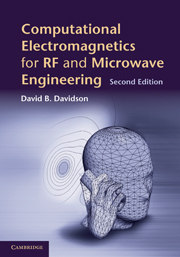Book contents
- Frontmatter
- Dedication
- Contents
- Preface to the second edition
- Preface to the first edition
- Acknowledgements
- To the reader
- List of notation
- 1 An overview of computational electromagnetics for RF and microwave applications
- 2 The finite difference time domain method: a one-dimensional introduction
- 3 The finite difference time domain method in two and three dimensions
- 4 A one-dimensional introduction to the method of moments: modelling thin wires and infinite cylinders
- 5 The application of the FEKO and NEC-2 codes to thin-wire antenna modelling
- 6 The method of moments for surface modelling
- 7 The method of moments and stratified media: theory
- 8 The method of moments and stratified media: practical applications of a commercial code
- 9 A one-dimensional introduction to the finite element method
- 10 The finite element method in two dimensions: scalar and vector elements
- 11 The finite element method in three dimensions
- 12 A selection of more advanced topics in full-wave computational electromagnetics
- Appendix A The Whitney element
- Appendix B The Newmark-β time-stepping algorithm References
- Appendix C On the convergence of the MoM Reference
- Appendix D Useful formulas for simplex coordinates
- Appendix E Web resources
- Appendix F MATLAB files supporting this text
- Index
Preface to the first edition
Published online by Cambridge University Press: 05 July 2014
- Frontmatter
- Dedication
- Contents
- Preface to the second edition
- Preface to the first edition
- Acknowledgements
- To the reader
- List of notation
- 1 An overview of computational electromagnetics for RF and microwave applications
- 2 The finite difference time domain method: a one-dimensional introduction
- 3 The finite difference time domain method in two and three dimensions
- 4 A one-dimensional introduction to the method of moments: modelling thin wires and infinite cylinders
- 5 The application of the FEKO and NEC-2 codes to thin-wire antenna modelling
- 6 The method of moments for surface modelling
- 7 The method of moments and stratified media: theory
- 8 The method of moments and stratified media: practical applications of a commercial code
- 9 A one-dimensional introduction to the finite element method
- 10 The finite element method in two dimensions: scalar and vector elements
- 11 The finite element method in three dimensions
- 12 A selection of more advanced topics in full-wave computational electromagnetics
- Appendix A The Whitney element
- Appendix B The Newmark-β time-stepping algorithm References
- Appendix C On the convergence of the MoM Reference
- Appendix D Useful formulas for simplex coordinates
- Appendix E Web resources
- Appendix F MATLAB files supporting this text
- Index
Summary
On graduating twenty years back, in 1984, my first job was as a research engineer working on computational electromagnetics (CEM) at the National Institute for Aeronautical Systems Technology (as it was then called) of the Council for Scientific and Industrial Research (CSIR) in Pretoria, South Africa. It was an exciting time to be working in this field. Although a number of methods had already been successfully introduced, including the three which will be discussed in detail in this book, major advances were being made in all of these methods, and the power of desktop computers was growing in leaps and bounds. No commercial programs (or codes, as they are generally called) were then available for RF problems, but some US government-sponsored codes, in particular the NEC-2 code, were becoming available for general use.
The 1980s saw the final decade of the Cold War, which in some areas (such as Southern Africa) was far from cold. New military technologies, in particular stealth, were driving CEM to address progressively more electromagnetically complex problems. However, when the Cold War ended, far from CEM work coming to a halt, new commercial markets, such as the rapidly developing market in mobile telephony and personal communication systems, and the proliferation of electronic systems in motor vehicles, continued to drive the technology forward at breakneck speed throughout the 1990s. This was also due to the widespread availability of cheap and progressively more powerful personal computers as a crucial enabling technology.
Information
- Type
- Chapter
- Information
- Computational Electromagnetics for RF and Microwave Engineering , pp. xvii - xxPublisher: Cambridge University PressPrint publication year: 2010
